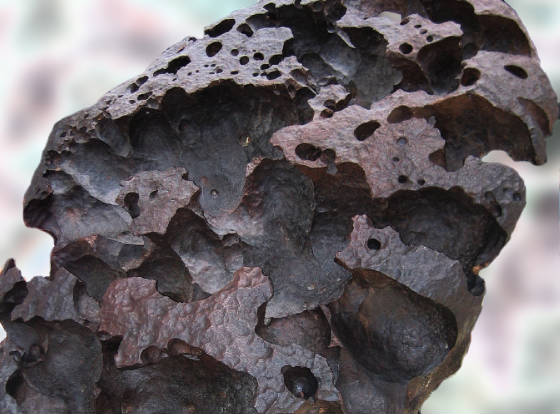Recently I revisited the Willamette meteorite -- a fifteen-ton immigrant from another planet that has enchanted me since childhood. Though it fell to Earth in the Pacific northwest millennia ago, the meteorite now resides at the Rose Center for Earth and Space in New York City.

I needed a new look at the old hulk after receiving a letter from a reader in Portland, Oregon, near the former home of the meteorite in the Willamette Valley.
John R. Bakkensen politely corrected an error in my description of the space rock's arrival. In The Planets, I had said that "it hurtled down to the Oregon ground at tremendous speed, burning up from the heat of friction, and hitting the valley floor with the impact of an atom bomb," when in fact the meteorite made first contact far north of that neighborhood.
The site of its cataclysmic landing could lie in what is now Washington state, or Montana or Idaho, or even Canada. The crater the meteorite must have gouged there has long since disappeared in the wake of ice ages and other weathering. The meteorite itself fell prey to a glacier, which swallowed it whole.
Some 15,000 years ago, the Missoula Floods coursed through the region like an ocean on the move, and carried the ice-encapsulated Willamette meteorite to a resting place near present-day Portland. The rare object's great size -- about ten feet by six feet by four feet -- drew the attention of the Clackamas tribe, who understood that it had come from "the moon." They gave it the name Tomanowos and venerated it for generations.
Ironically the meteorite, which consists almost entirely of extraterrestrial iron, occupied property owned by the Oregon Iron & Steel Company. In 1902 the company sued Ellis Hughes for stealing the stone, which could hardly be described as rolling. Hughes had wrestled it to his own land -- a journey of less than a mile that took 90 days -- and was charging a fee to let people see it.
In court, Hughes pleaded "Finders, keepers." Had the meteorite truly burrowed down into that patch of Oregon ground, then, Hughes allowed, he might be guilty of larceny. However, the meteorite (or "aerolite" as it was also known in those days) stood on the ground, not in the ground. Hughes tried to prove the Clackamas had dug it up and moved it to the veneration site, but later abandoned it, leaving it ripe for appropriation by anyone who came along. When he lost the case, he appealed to the Oregon Supreme Court -- and lost again.
Mr. Bakkensen included a transcript of the higher Court's 1905 judgment with his note:
"And it was held that [the aerolite], having none of the characteristics of personalty" -- i.e. unclaimed personal property -- "became, by falling on the earth through the course of nature, a part of the soil, and hence that the ownership was determined by the ownership of the soil."
